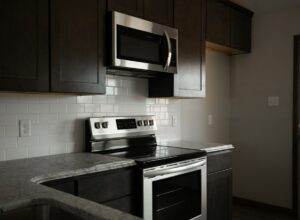Proper freezer maintenance is essential for ensuring the longevity and efficiency of your appliance. Neglecting freezer maintenance can lead to costly repairs and even health hazards. In this article, we will discuss the importance of proper freezer maintenance, the benefits it provides, common issues that can arise, and how to address them. By understanding the importance of regular maintenance and taking proactive steps to care for your freezer, you can avoid unnecessary expenses and keep your food safe.
Key Takeaways
- Proper freezer maintenance is crucial for ensuring its longevity and efficiency.
- Common door issues include frost build-up, difficulty closing, and leaks.
- Ignoring freezer problems can lead to food spoilage and even health hazards.
- Regular defrosting can improve freezer performance and prevent frost build-up.
- Automatic defrosting is more convenient, but manual defrosting is more thorough.
Understanding the Importance of Proper Freezer Maintenance
Proper freezer maintenance offers several benefits. Firstly, it extends the lifespan of your appliance. Regular maintenance helps to prevent issues that can lead to breakdowns and costly repairs. By addressing minor problems early on, you can avoid major malfunctions that may require professional intervention.
Secondly, proper maintenance improves energy efficiency. When a freezer is not properly maintained, it has to work harder to maintain the desired temperature. This results in increased energy consumption and higher utility bills. By keeping your freezer clean and well-maintained, you can ensure that it operates at peak efficiency.
Regular maintenance also helps to prevent common issues such as frost build-up and door seal problems. Frost build-up can restrict airflow and reduce the cooling capacity of your freezer. It can also make it difficult to access items stored inside. Door seal problems, such as gaps or tears in the gasket, can lead to warm air entering the freezer and causing temperature fluctuations.
Common Door Issues and How to Identify Them
One common issue with freezer doors is difficulty opening and closing. If you find that your freezer door is sticking or not closing properly, it may be due to a problem with the door seal or hinges. Another common issue is frost build-up around the edges of the door. This can indicate a problem with the door seal or a faulty gasket.
To identify these issues, visually inspect the door seal for any signs of wear, tears, or gaps. You can also perform a simple dollar bill test. Close the door on a dollar bill and try to pull it out. If you can easily remove the bill without resistance, it may be a sign that the door seal is not creating a proper seal.
It is important to address these issues promptly as they can lead to increased energy consumption and potential food spoilage. Additionally, if warm air is entering the freezer, it can cause the compressor to work harder, leading to increased wear and tear on the appliance.
The Dangers of Ignoring Freezer Problems
| Freezer Problem | Danger |
|---|---|
| Ice buildup | Reduced cooling efficiency, increased energy consumption |
| Door seal damage | Warm air infiltration, food spoilage, increased energy consumption |
| Malfunctioning thermostat | Temperature fluctuations, food spoilage, increased energy consumption |
| Power outage | Food spoilage, potential health hazards |
| Refrigerant leak | Reduced cooling efficiency, increased energy consumption, potential health hazards |
Ignoring freezer problems can have serious consequences. One of the most significant dangers is food spoilage. If your freezer is not maintaining the proper temperature, perishable items can thaw and spoil. This not only results in wasted food but also poses health risks if consumed.
Another danger of ignoring freezer problems is the potential for increased energy consumption. When a freezer is not functioning properly, it has to work harder to maintain the desired temperature. This leads to higher energy bills and puts unnecessary strain on the appliance.
By addressing issues promptly, you can prevent these dangers. Regular maintenance and timely repairs ensure that your freezer operates efficiently and keeps your food safe.
The Benefits of Regular Defrosting
Regular defrosting is an essential part of freezer maintenance. It offers several benefits, including improved energy efficiency and preventing frost build-up.
When frost builds up in your freezer, it restricts airflow and reduces the cooling capacity of the appliance. This means that it has to work harder to maintain the desired temperature, resulting in increased energy consumption. By regularly defrosting your freezer, you can remove excess frost and ice, allowing it to operate more efficiently.
Regular defrosting also helps to prevent frost build-up in the future. When frost accumulates, it can make it difficult to access items stored in the freezer and reduce available storage space. By defrosting regularly, you can prevent this issue and ensure that your freezer remains organized and functional.
Neglecting defrosting can lead to costly repairs and even damage to the freezer. Excessive frost build-up can cause the evaporator coils to freeze, resulting in reduced cooling capacity and potential damage to the compressor. By taking the time to defrost your freezer regularly, you can avoid these issues and extend the lifespan of your appliance.
Manual Defrosting vs. Automatic Defrosting: Which is Better?

There are two main methods of defrosting a freezer: manual defrosting and automatic defrosting. Each method has its pros and cons, and the best choice depends on your specific needs and preferences.
Manual defrosting involves turning off the freezer, removing all items, and allowing the frost to melt naturally. This process can take several hours or even overnight. Once the frost has melted, you can clean the interior of the freezer and dry it thoroughly before turning it back on.
Automatic defrosting, on the other hand, is a feature found in some modern freezers. These freezers have a built-in mechanism that periodically heats up the evaporator coils to melt any accumulated frost. The melted water is then drained away, eliminating the need for manual defrosting.
The main advantage of manual defrosting is that it allows you to thoroughly clean the interior of the freezer during the process. This can help remove any lingering odors or spills and keep your freezer fresh. However, manual defrosting requires more time and effort compared to automatic defrosting.
Automatic defrosting offers convenience as it eliminates the need for manual intervention. The built-in mechanism takes care of melting the frost, allowing you to focus on other tasks. However, automatic defrosting may not be as thorough as manual defrosting when it comes to cleaning the interior of the freezer.
Ultimately, the choice between manual and automatic defrosting depends on your personal preference and the specific features of your freezer. If you prefer a hands-on approach and want to ensure a thorough cleaning, manual defrosting may be the better option. However, if convenience is a priority for you, an automatic defrosting freezer may be the way to go.
Step-by-Step Guide to Defrosting Your Freezer
If you have opted for manual defrosting, here is a step-by-step guide to help you through the process:
1. Prepare for defrosting: Start by gathering the necessary tools and supplies. You will need a cooler or insulated bags to store your frozen items while defrosting. You will also need towels or absorbent mats to catch any water that may drip during the process.
2. Empty the freezer: Remove all items from the freezer and place them in the cooler or insulated bags. Take this opportunity to sort through your items and discard any expired or unwanted food.
3. Turn off the freezer: Locate the power switch or unplug the freezer from the electrical outlet. This will prevent any accidental cooling during the defrosting process.
4. Speed up the process (optional): If you want to speed up the defrosting process, you can place bowls of hot water inside the freezer. Close the door and allow the steam to help melt the frost faster.
5. Remove excess frost: Once most of the frost has melted, use a plastic scraper or spatula to gently remove any remaining frost or ice. Be careful not to use sharp objects that could damage the interior of the freezer.
6. Clean the interior: Once all the frost has melted and been removed, clean the interior of the freezer using a mild detergent or vinegar solution. Wipe down all surfaces, including shelves and drawers, and dry them thoroughly.
7. Dry and reassemble: Use towels or absorbent mats to dry any remaining moisture in the freezer. Once everything is dry, reassemble the shelves and drawers and return the items to the freezer.
8. Turn on the freezer: Plug the freezer back into the electrical outlet or turn on the power switch. Allow the freezer to cool down for a few hours before returning it to regular use.
Tips for Preventing Frost Build-Up
Preventing frost build-up in your freezer can help maintain its efficiency and prevent costly repairs. Here are some tips to help you avoid excessive frost accumulation:
1. Proper storage: Properly packaging and sealing your food before placing it in the freezer can help prevent moisture from entering and causing frost build-up. Use airtight containers or freezer bags to store your items.
2. Temperature control: Ensure that your freezer is set to the correct temperature. Most freezers should be set between 0°F and -10°F (-18°C and -23°C) for optimal performance. Avoid setting the temperature too low as this can lead to increased frost build-up.
3. Avoid overloading: Overloading your freezer can restrict airflow and lead to increased frost accumulation. Leave enough space between items for air to circulate freely.
4. Regularly clean the interior: Regularly cleaning the interior of your freezer helps remove any spills or debris that could contribute to frost build-up. Use a mild detergent or vinegar solution and wipe down all surfaces thoroughly.
5. Check door seal: Regularly inspect the door seal for any signs of wear, tears, or gaps. If you notice any issues, replace the door seal promptly to ensure a proper seal.
By following these tips, you can prevent excessive frost build-up and keep your freezer running efficiently.
Fixing Door Seal Issues: DIY vs. Professional Help
If you are experiencing door seal issues with your freezer, you may be wondering whether to fix it yourself or seek professional help. Here are some factors to consider:
DIY Fixes:
– If the issue is minor, such as a loose seal or a small tear in the gasket, you may be able to fix it yourself. There are DIY repair kits available that include replacement gaskets and adhesive.
– DIY fixes are generally more cost-effective than hiring a professional. However, it is important to ensure that you have the necessary skills and tools to complete the repair successfully.
– Before attempting a DIY fix, consult the freezer’s manual or manufacturer’s website for specific instructions and guidelines.
Professional Help:
– If the door seal issue is significant or if you are unsure about your ability to fix it yourself, it is best to seek professional help. A professional technician will have the expertise and tools to diagnose and repair the problem correctly.
– Hiring a professional ensures that the repair is done properly, reducing the risk of further damage or recurring issues.
– While professional repairs may be more expensive, they offer peace of mind and can save you time and frustration.
Ultimately, the decision between DIY fixes and professional help depends on your comfort level with repairs and the severity of the door seal issue. If in doubt, it is always best to consult a professional technician.
How to Replace a Faulty Freezer Door Gasket
If you have determined that your freezer door gasket needs to be replaced, here is a step-by-step guide to help you through the process:
1. Purchase a replacement gasket: Measure the dimensions of your current gasket and purchase a replacement that matches those dimensions. You can find replacement gaskets at appliance stores or online retailers.
2. Prepare for replacement: Gather the necessary tools for the job, including a screwdriver, pliers, and a hairdryer or heat gun. Turn off the freezer and unplug it from the electrical outlet.
3. Remove the old gasket: Starting at one corner, carefully peel back the old gasket from the door. Use a screwdriver or pliers to remove any screws or clips that are securing the gasket in place.
4. Clean the door: Once the old gasket is removed, clean the door surface thoroughly. Use a mild detergent or vinegar solution to remove any residue or debris. Dry the surface completely before proceeding.
5. Soften the new gasket: To make it easier to install, soften the new gasket by heating it with a hairdryer or heat gun. Be careful not to overheat or melt the gasket.
6. Install the new gasket: Starting at one corner, press the new gasket firmly onto the door surface. Work your way around the door, ensuring that the gasket is properly aligned and securely attached.
7. Secure the gasket: If your freezer has screws or clips to secure the gasket, use a screwdriver or pliers to reattach them. Make sure that the gasket is held firmly in place.
8. Test the seal: Close the freezer door and check for any gaps or leaks in the seal. If necessary, adjust the position of the gasket to ensure a proper seal.
9. Plug in and test: Once you are satisfied with the installation, plug in the freezer and turn it on. Allow it to cool down for a few hours before returning it to regular use.
Replacing a faulty freezer door gasket can help restore proper sealing and prevent warm air from entering the freezer. If you are unsure about your ability to replace the gasket yourself, it is best to seek professional help.
Maintaining Your Freezer for Long-Term Performance and Efficiency
Regular maintenance is key to ensuring long-term performance and efficiency of your freezer. Here are some tips for ongoing maintenance:
1. Clean regularly: Regularly clean the interior of your freezer using a mild detergent or vinegar solution. Wipe down all surfaces, including shelves and drawers, and dry them thoroughly.
2. Check the temperature: Monitor the temperature of your freezer regularly to ensure that it is maintaining the desired range. Adjust the temperature settings if necessary.
3. Organize your items: Keep your freezer organized to maximize storage space and improve airflow. Use labeled containers or bins to group similar items together.
4. Check the door seal: Regularly inspect the door seal for any signs of wear, tears, or gaps. If you notice any issues, replace the door seal promptly to ensure a proper seal.
5. Avoid overloading: Avoid overloading your freezer as it can restrict airflow and lead to increased energy consumption. Leave enough space between items for air to circulate freely.
6. Check for leaks: Periodically check for any leaks or water accumulation around the freezer. This could indicate a problem with the defrost drain or other components that require attention.
By following these maintenance tips, you can keep your freezer running efficiently and extend its lifespan.
Proper freezer maintenance is essential for optimal performance and safety. Neglecting maintenance can lead to costly repairs and even health hazards. By understanding the importance of regular maintenance and taking proactive steps to care for your freezer, you can avoid unnecessary expenses and keep your food safe.
Regular maintenance offers several benefits, including longer lifespan and improved energy efficiency. It helps prevent common issues such as frost build-up and door seal problems. By addressing these issues promptly, you can prevent food spoilage, reduce energy waste, and save money on utility bills. Regular maintenance also allows for early detection of potential problems, such as malfunctioning components or refrigerant leaks, which can be costly to repair if left unattended. Additionally, proper maintenance ensures that the refrigerator operates at its optimal performance, keeping food at the right temperature and preserving its quality for longer periods. Overall, regular maintenance is essential for maximizing the lifespan and efficiency of a refrigerator while minimizing the risk of unexpected breakdowns and costly repairs.
If you’re dealing with frustrating frost and door issues in your freezer, you’re not alone. But don’t worry, help is just a click away! Check out our related article on 911 Appliance’s blog that provides valuable tips and tricks for tackling these common freezer problems. From preventing frost buildup to fixing a faulty door seal, this article has got you covered. Don’t let freezer frustrations ruin your day – click here to read the article and find the solutions you need: https://911Appliance.com/our-blog/.
How Can I Fix Freezer Door Issues and Defrosting Problems Like a Pro?
When troubleshooting door lid issues fix on your freezer, start by checking the seal for any gaps or tears. Use a hairdryer to gently defrost any ice buildup on the door. If the problem persists, consider replacing the gasket to ensure a tight seal and prevent future defrosting problems.



